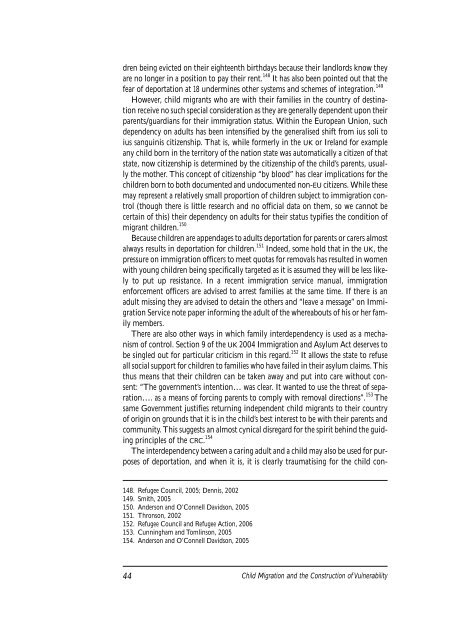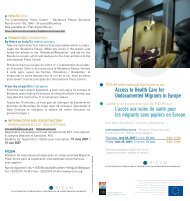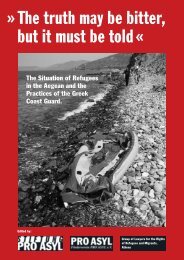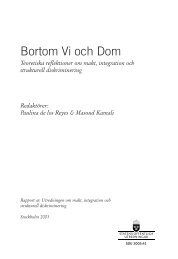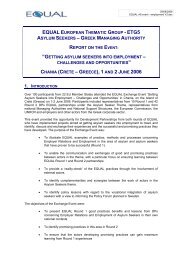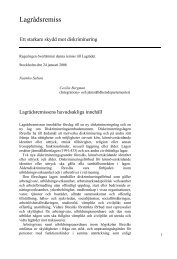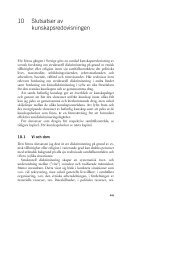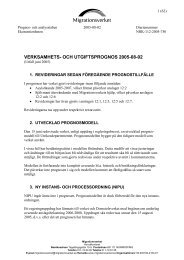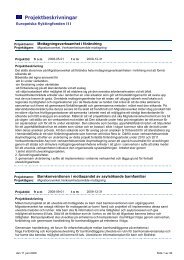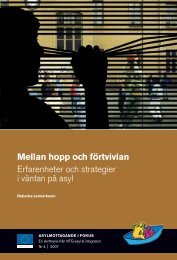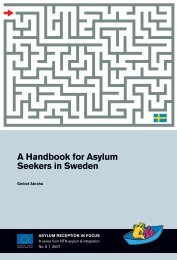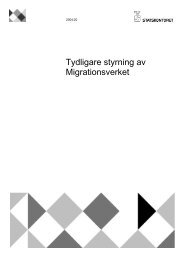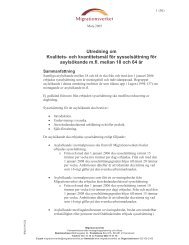and the Construction of Vulnerability - Child Trafficking
and the Construction of Vulnerability - Child Trafficking
and the Construction of Vulnerability - Child Trafficking
You also want an ePaper? Increase the reach of your titles
YUMPU automatically turns print PDFs into web optimized ePapers that Google loves.
dren being evicted on <strong>the</strong>ir eighteenth birthdays because <strong>the</strong>ir l<strong>and</strong>lords know <strong>the</strong>y<br />
are no longer in a position to pay <strong>the</strong>ir rent. 148 It has also been pointed out that <strong>the</strong><br />
fear <strong>of</strong> deportation at 18 undermines o<strong>the</strong>r systems <strong>and</strong> schemes <strong>of</strong> integration. 149<br />
However, child migrants who are with <strong>the</strong>ir families in <strong>the</strong> country <strong>of</strong> destination<br />
receive no such special consideration as <strong>the</strong>y are generally dependent upon <strong>the</strong>ir<br />
parents/guardians for <strong>the</strong>ir immigration status. Within <strong>the</strong> European Union, such<br />
dependency on adults has been intensified by <strong>the</strong> generalised shift from ius soli to<br />
ius sanguinis citizenship. That is, while formerly in <strong>the</strong> UK or Irel<strong>and</strong> for example<br />
any child born in <strong>the</strong> territory <strong>of</strong> <strong>the</strong> nation state was automatically a citizen <strong>of</strong> that<br />
state, now citizenship is determined by <strong>the</strong> citizenship <strong>of</strong> <strong>the</strong> child’s parents, usually<br />
<strong>the</strong> mo<strong>the</strong>r. This concept <strong>of</strong> citizenship “by blood” has clear implications for <strong>the</strong><br />
children born to both documented <strong>and</strong> undocumented non-EU citizens. While <strong>the</strong>se<br />
may represent a relatively small proportion <strong>of</strong> children subject to immigration control<br />
(though <strong>the</strong>re is little research <strong>and</strong> no <strong>of</strong>ficial data on <strong>the</strong>m, so we cannot be<br />
certain <strong>of</strong> this) <strong>the</strong>ir dependency on adults for <strong>the</strong>ir status typifies <strong>the</strong> condition <strong>of</strong><br />
migrant children. 150<br />
Because children are appendages to adults deportation for parents or carers almost<br />
always results in deportation for children. 151 Indeed, some hold that in <strong>the</strong> UK, <strong>the</strong><br />
pressure on immigration <strong>of</strong>ficers to meet quotas for removals has resulted in women<br />
with young children being specifically targeted as it is assumed <strong>the</strong>y will be less likely<br />
to put up resistance. In a recent immigration service manual, immigration<br />
enforcement <strong>of</strong>ficers are advised to arrest families at <strong>the</strong> same time. If <strong>the</strong>re is an<br />
adult missing <strong>the</strong>y are advised to detain <strong>the</strong> o<strong>the</strong>rs <strong>and</strong> “leave a message” on Immigration<br />
Service note paper informing <strong>the</strong> adult <strong>of</strong> <strong>the</strong> whereabouts <strong>of</strong> his or her family<br />
members.<br />
There are also o<strong>the</strong>r ways in which family interdependency is used as a mechanism<br />
<strong>of</strong> control. Section 9 <strong>of</strong> <strong>the</strong> UK 2004 Immigration <strong>and</strong> Asylum Act deserves to<br />
be singled out for particular criticism in this regard. 152 It allows <strong>the</strong> state to refuse<br />
all social support for children to families who have failed in <strong>the</strong>ir asylum claims. This<br />
thus means that <strong>the</strong>ir children can be taken away <strong>and</strong> put into care without consent:<br />
“The government’s intention… was clear. It wanted to use <strong>the</strong> threat <strong>of</strong> separation….<br />
as a means <strong>of</strong> forcing parents to comply with removal directions”. 153 The<br />
same Government justifies returning independent child migrants to <strong>the</strong>ir country<br />
<strong>of</strong> origin on grounds that it is in <strong>the</strong> child’s best interest to be with <strong>the</strong>ir parents <strong>and</strong><br />
community. This suggests an almost cynical disregard for <strong>the</strong> spirit behind <strong>the</strong> guiding<br />
principles <strong>of</strong> <strong>the</strong> CRC. 154<br />
The interdependency between a caring adult <strong>and</strong> a child may also be used for purposes<br />
<strong>of</strong> deportation, <strong>and</strong> when it is, it is clearly traumatising for <strong>the</strong> child con-<br />
148. Refugee Council, 2005; Dennis, 2002<br />
149. Smith, 2005<br />
150. Anderson <strong>and</strong> O’Connell Davidson, 2005<br />
151. Thronson, 2002<br />
152. Refugee Council <strong>and</strong> Refugee Action, 2006<br />
153. Cunningham <strong>and</strong> Tomlinson, 2005<br />
154. Anderson <strong>and</strong> O’Connell Davidson, 2005<br />
44<br />
<strong>Child</strong> Migration <strong>and</strong> <strong>the</strong> <strong>Construction</strong> <strong>of</strong> <strong>Vulnerability</strong>


